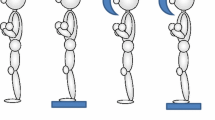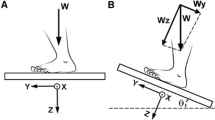Abstract
In an earlier posturographic investigation (Collins and De Luca 1993) it was proposed that open-loop and closed-loop control mechanisms are involved in the regulation of undisturbed, upright stance. In this study, stabilogram-diffusion analysis was used to examine how the natural aging process affects the operational characteristics of these control mechanisms. Stabilogram-diffusion analysis leads to the extraction of repeatable center-of-pressure (COP) parameters that can be directly related to the steady-state behavior and functional interaction of the neuromuscular mechanisms underlying the maintenance of erect posture. Twenty-five healthy young males (aged 19–30 years) and twenty-five elderly males (aged 71–80 years) who were free of major gait and postural disorders were included in the study. An instrumented force platform was used to measure the time-varying displacements of the COP under each subject's feet during quiet standing. The COP trajectories were analyzed as one-dimensional and two-dimensional random walks, according to stabilogram-diffusion analysis. Using this technique, it was demonstrated cross-sectionally that healthy aging is associated with significant changes in the ‘quasi-static’ dynamics of the postural control system. (It was also shown that more traditional posturographic analyses, i.e., summary statistics, were not sensitive enough to detect these age-related differences.) It was found that the steady-state behavior of the open-loop postural control mechanisms in the elderly is more positively correlated and therefore perhaps more unstable, i.e., the output of the overall system has a greater tendency to move or drift away from a relative equilibrium point over the short term. In contrast with this result, it was also found that the steady-state behavior of the closed-loop postural control mechanisms in the elderly is more negatively correlated and therefore perhaps more stable, i.e., over the longer term, there is an increased probability that movements away from a relative equilibrium point will be offset by corrective adjustments back towards the equilibrium position. In addition, it was demonstrated that the elderly utilize open-loop control schemes for longer time intervals and correspondingly larger COP displacements during periods of undisturbed stance. This result suggests that in the elderly there is a greater delay, on average, before closed-loop feedback mechanisms are called into play. Finally, it was shown that there is an increased heterogeneity of postural control abilities in healthy older adults.
Similar content being viewed by others
References
Alexander NB (1994) Postural control in older adults. J Am Geriatr Soc 42:93–108
Alexander NB, Shepard N, Gu MJ, Schultz A (1992) Postural control in young and elderly adults when stance is perturbed: kinematics. J Gerontol 47:M79–87
Collins JJ, De Luca CJ (1993) Open-loop and closed-loop control of posture: a random-walk analysis of center-of-pressure trajectories. Exp Brain Res 95:308–318
Collins JJ, De Luca CJ (1994) Random walking during quiet standing. Phys Rev Lett 73:764–767
Collins JJ, De Luca CJ (1995a) The effects of visual input on open-loop and closed-loop postural control mechanisms. Exp Brain Res 103:151–163
Collins JJ, De Luca CJ (1995b) Upright, correlated random walks: a statistical-biomechanics approach to the human postural control system. CHAOS 5:57–63
De Luca CJ, LeFever RS, McCue MP, Xenakis AP (1982) Control scheme governing concurrently active human motor units during voluntary contractions. J Physiol (Lond) 329:129–142
Dorfman LJ, Bosley TM (1979) Age-related changes in peripheral and central nerve conduction in man. Neurology 29:38–44
Dornan J, Fernie GR, Holliday PJ (1978) Visual input: its importance in the control of postural sway. Arch Phys Med Rehab 59:586–591
Era P, Heikkinen E (1985) Postural sway during standing and unexpected disturbance of balance in random samples of men of different age groups. J Gerontol 40:287–295
Faulkner JA, Brooks SV, Zerba E (1990) Skeletal muscle weakness and fatigue in old age: underlying mechanisms. Annu Rev Gerontol Geriatr 10:147–166
Feder J (1988) Fractals. Plenum Press, New York
Fernie GR, Gryfe CI, Holliday PJ, Llewellyn A (1982) The relationship of postural sway in standing to the incidence of falls in geriatric subjects. Age Ageing 11:11–16
Folstein MF, Folstein S, McHugh PR (1975) Mini-mental state. J Psychiatr Res 12:189–196
Hasan SS, Lichtenstein MJ, Shiavi RG (1990) Effects of loss of balance on biomechanics platform measures of sway: influence of stance and a method for adjustment. J Biomech 23:783–789
Hasselkus BR, Shambes GM (1975) Aging and postural sway in women. J Gerontol 30:661–667
Horak FB, Shupert CL, Mirka A (1989) Components of postural dyscontrol in the elderly: a review. Neurobiol Aging 10:727–738
Hytönen M, Pyykkö I, Aalto H, Starck J (1993) Postural control and age. Acta Otolaryngol (Stockh) 113:119–122
Inglin B, Woollacott M (1988) Age-related changes in anticipatory postural adjustments associated with arm movements. J Gerontol 43:M105–113
Joyce GC, Rack PMH (1974) The effects of load and force on tremor at the normal human elbow joint. J Physiol (Lond) 240:375–396
Lipsitz LA, Jonsson PV, Kelley MM, Koestner JS (1991) Causes and correlates of recurrent falls in ambulatory frail elderly. J Gerontol 46:M114–122
Lord SR, Clark RD, Webster IW (1991) Postural stability and associated physiological factors in a population of aged persons. J Gerontol 46:M69–76
Maki BE, Holliday PJ, Fernie GR (1987) A posture control model and balance test for the prediction of relative postural stability. IEEE Trans Biomed Eng 34:797–810
Maki BE, Holliday PJ, Topper AK (1991) Fear of falling and postural performance in the elderly. J Gerontol 46:M123–131
Manchester D, Woollacott M, Zederbauer-Hylton N, Marin O (1989) Visual, vestibular and somatosensory contributions to balance control in the older adult. J Gerontol 44:M118–127
Overstall PW, Exton-Smith AN, Imms FJ, Johnson AL (1977) Falls in the elderly related to postural imbalance. Br Med J 1:261–264
Prieto TE, Myklebust JB, Myklebust BM (1993) Characterization and modeling of postural steadiness in the elderly: a review. IEEE Trans Rehab Eng 1:26–34
Pyykkö I, Jäntti P, Aalto H (1990) Postural control in elderly subjects. Age Ageing 19:215–221
Ring C, Nayak USL, Isaacs B (1989) The effect of visual deprivation and proprioceptive change on postural sway in healthy adults. J Am Geriatr Soc 37:745–749
Saupe D (1988) Algorithms for random fractals. In: Peitgen H-O, Saupe D (eds) The science of fractal images. Springer, New York Berlin Heidelberg, pp 71–136
Sheldon JH (1963) The effect of age on the control of sway. Gerontol Clin 5:129–138
Skinner HB, Barrack RL, Cook SD (1984) Age-related decline in proprioception. Clin Orthop 184:208–211
Stelmach GE, Phillips J, DiFabio RP, Teasdale N (1989) Age, functional postural reflexes, and voluntary sway. J Gerontol 44:B100–106
Stelmach GE, Populin L, Müller F (1990) Postural muscle onset and voluntary movement in the elderly. Neurosci Lett 117:188–193
Tinetti ME, Speechley M (1989) Prevention of falls among the elderly. N Engl J Med 320:1055–1059
Tinetti ME, Speechley M, Ginter SF (1988) Risk factors for falls among elderly persons living in the community. N Engl J Med 319:1701–1707
Whanger AD, Wang HS (1974) Clinical correlates of the vibratory sense in elderly psychiatric patients. J Gerontol 29:39–45
Winters J, Stark L, Seif-Naraghi A-H (1988) An analysis of the sources of musculoskeletal system impedance. J Biomech 21:1011–1025
Woollacott MH, Shumway-Cook A, Nashner LM (1986) Aging and postural control: changes in sensory organization and muscular organization. Int J Aging Hum Dev 23:97–114
Yesavage JA, Sheikh JI (1986) Geriatric depression scale. Clin Gerontol 5:165–172
Author information
Authors and Affiliations
Rights and permissions
About this article
Cite this article
Collins, J.J., De Luca, C.J., Burrows, A. et al. Age-related changes in open-loop and closed-loop postural control mechanisms. Exp Brain Res 104, 480–492 (1995). https://doi.org/10.1007/BF00231982
Received:
Accepted:
Issue Date:
DOI: https://doi.org/10.1007/BF00231982




